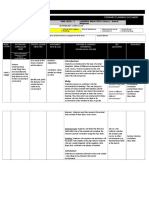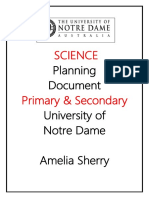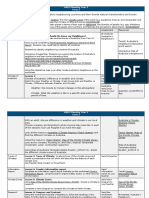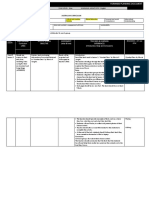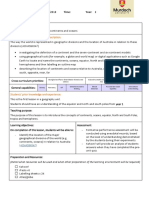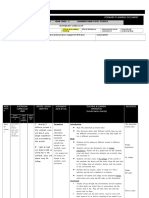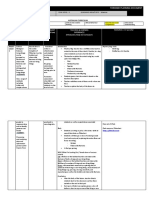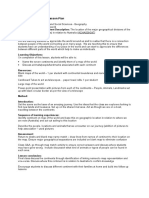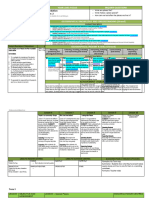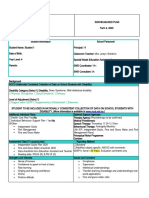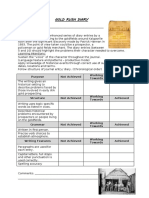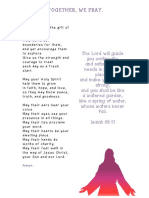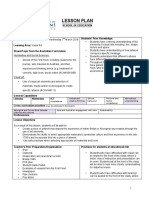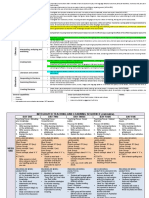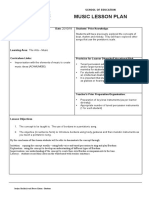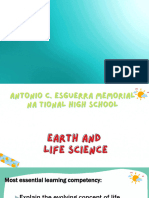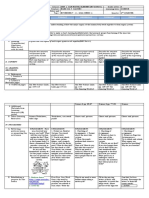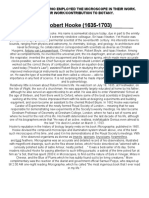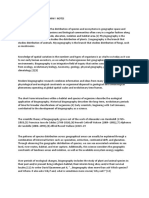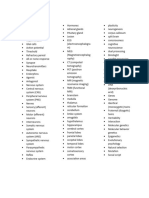Hass Term Overview
Hass Term Overview
Uploaded by
api-350463121Copyright:
Available Formats
Hass Term Overview
Hass Term Overview
Uploaded by
api-350463121Original Title
Copyright
Available Formats
Share this document
Did you find this document useful?
Is this content inappropriate?
Copyright:
Available Formats
Hass Term Overview
Hass Term Overview
Uploaded by
api-350463121Copyright:
Available Formats
Year 4 HASS Term Overview
Term 3, 2021
Mrs Marni Vollprecht & Miss Jordyn Sheldrick
WEEK CURRICULUM OUTCOMES Learning Intention/s Resources/Assessment
Scsa Math Curriculum v8.1
1 Curriculum Content: Map the 7 Continents of Resources:
The main characteristics the World. World Map Jigsaw
(e.g. climate, natural vegetation, Map Australia. Australia Blank map
landforms, native animals) of the Examine the continent ‘Africa PowerPoint’
continents of Africa and Europe, and the of Africa. Assessment:
location of their major countries in relation Work Sample: Are students able to map the according places/land masses?
to Australia (ACHASSK087) Judging Standard:
Locates some selected places on a map and identifies the main
characteristics of the natural environments of Africa and Europe.
2 Curriculum Content: Examine the Continent Resources:
The main characteristics of Africa. ‘Africa’ PowerPoint
(e.g. climate, natural vegetation, Describe the climate of Africa Map
landforms, native animals) of the Africa. All About Africa activity sheet.
continents of Africa and Europe, and the Describe the vegetation Assessment:
location of their major countries in relation and landforms of Africa. Work Sample: Are students able to map the according places/land masses?
to Australia (ACHASSK087) Describe the animals Are students able to describe the continent of Africa?
that inhabit the African Judging Standard:
continent. Locates some selected places on a map and identifies the main
characteristics of the natural environments of Africa and Europe.
Describes the interconnections between places, people and animals at the
local and/or global scale.
3 Curriculum Content: Examine the Continent Resources
The main characteristics of Europe. ‘Europe’ PowerPoint
(e.g. climate, natural vegetation, Describe the climate of Europe Map
landforms, native animals) of the Europe. Exciting Europe activity sheet.
continents of Africa and Europe, and the Describe the vegetation Assessment
location of their major countries in relation and landforms of Work Sample: Are students able to map the according places/land masses?
to Australia (ACHASSK087) Europe. Are students able to describe the continent of Europe?
Describe the animals Judging Standard:
that inhabit the Locates some selected places on a map and identifies the main
European continent. characteristics of the natural environments of Africa and Europe.
Describes the interconnections between places, people and animals at the
local and/or global scale.
4 Curriculum Content: Explain the Biomes that Resources
The main characteristics exist in Australia. Biomes PowerPoint
(e.g. climate, natural vegetation, Describe the Biomes Biome Activity sheet.
landforms, native animals) of the that exist around the Assessment
continents of Africa and Europe, and the world. Work sample – are students able to identify different Biomes from around the
location of their major countries in relation
world.
to Australia (ACHASSK087)
Judging Standard:
Locates some selected places on a map and identifies the main
characteristics of the natural environments of Africa and Europe.
Describes the interconnections between places, people and animals at the
local and/or global scale.
5 Curriculum Content: Compare and contrast Resources
The main characteristics the Biomes that exist in Link to Art diorama.
(e.g. climate, natural vegetation, Australia compared to
landforms, native animals) of the Africa and Europe. Assessment
continents of Africa and Europe, and the
Link to Art diorama.
location of their major countries in relation
Judging Standard:
to Australia (ACHASSK087)
Locates some selected places on a map and identifies the main
characteristics of the natural environments of Africa and Europe.
Describes the interconnections between places, people and animals at the
local and/or global scale.
6 Curriculum Content: Students define what a Resources
The importance of environments to animals resource is, where it Recourse Match Up Worksheet.
and people, and different views on how they comes from and recall Large paper with graffiti topics on them e.g. wood, water, meat, paper and
can be protected (ACHASSK088) examples of uses. fabric
The natural resources (e.g. water, timber, Students compare Renewable/Non-Renewable Posters
minerals) provided by the environment and
different views on how they can be used
renewable and non- Renewable/Non-renewable Cut and Paste.
sustainably (ACHASSK090) renewable resources Assessment
and understand the Work Sample: Worksheet- Students are able to correctly match each resource
difference between the to where they came from.
two. Students are able to correctly sort renewable from non-renewable resources.
Judging Standard:
Describes the interconnections between places, people and animals at the
local and/or global scale.
Identifies different views of how the environment can be managed and/or
protected.
7 Curriculum Content: Students understand Resources
The importance of environments to animals what sustainability is Sustainability Sheet
and people, and different views on how they and why it is necessary. Original Sustainability Definition
can be protected (ACHASSK088)
The natural resources (e.g. water, timber,
Students examine the Sustainability as a fairy tail: https://www.youtube.com/watch?
different types of v=fKWQuU0sHPw
minerals) provided by the environment and
vegetation.
different views on how they can be used Sustainability: https://www.youtube.com/watch?v=hHl09q5kk0k
sustainably (ACHASSK090)
3 Pillars Video: https://www.youtube.com/watch?v=ijSSe66865w
Radio Broadcast http://splash.abc.net.au/home#!/media/525907/indigenous-
perspective-on-sustainability
Discussion Topic
Types of Vegetation Retrieval Charts – PREP: On each sheet highlight one
type, swapping colours each time you repeat headings. If your number of
students is not a multiple of 5 you will need to double up some headings and
colours.
Types of vegetation posters
Animal Presentation
Assessment
Sustainability sheet- Students have correctly defined sustainability, described
the three pillars and give examples of each.
Summative: Types of Vegetation Retrieval Chart- Students completed
retrieval chart with all sections filled in.
Judging Standard:
Describes the interconnections between places, people and animals at the
local and/or global scale.
Identifies different views of how the environment can be managed and/or
protected.
8 Curriculum Content: Students describe the Resources
The importance of environments to animals importance of habitats, Protecting Animal Habitats Comprehension (Includes answer key)
and people, and different views on how they the environment and Why is the Environment Important? Answer template (or they can do it on
can be protected (ACHASSK088) vegetation to animals. lined paper).
The natural resources (e.g. water, timber,
Assessment
minerals) provided by the environment and
different views on how they can be used Summative: Why is the Environment Important? Answer- Students are able
to give reasons why the environment is important.
sustainably (ACHASSK090) Judging Standard:
Describes the interconnections between places, people and animals at the
local and/or global scale.
Identifies different views of how the environment can be managed and/or
protected.
9 Curriculum Content: Students summarise the Resources
The importance of environments to animals local waste Waste Flow Chart 웃
and people, and different views on how they management and
can be protected (ACHASSK088) Recycling Video: https://www.youtube.com/watch?v=NYux4-KIY1o
recycling program.
The natural resources (e.g. water, timber, https://www.youtube.com/watch?v=3N8EdY76xPs
minerals) provided by the environment and (This one is Australian but has no speaking so doesn’t give the answers to what
different views on how they can be used the recyclables are turned into.)
sustainably (ACHASSK090)
Extra video on organic waste if desired: https://www.youtube.com/watch?
v=ob-eiooULjw
Assessment
Formative: Worksheet- Students correctly complete the flow chart.
Judging Standard:
Describes the interconnections between places, people and animals at the
local and/or global scale.
Identifies different views of how the environment can be managed and/or
protected.
10 Curriculum Content: Students analyse how Resources
The importance of environments to animals resources are used in Post it notes for Card Cluster so results can be sorted on to a board
and people, and different views on how they their school and its Paper for group brainstorms
can be protected (ACHASSK088) sustainability practices. Information on a local organisation or group that manages natural vegetation
The natural resources (e.g. water, timber, Students identify in your local community. You can tell students about it, provide a fact sheet,
minerals) provided by the environment and
different views on how they can be used
important vegetation in explore their website or bring in a guest speaker.
sustainably (ACHASSK090) the local community and Organisation/Group Questions
how it is sustained. Judging Standard:
Describes the interconnections between places, people and animals at the
local and/or global scale.
Identifies different views of how the environment can be managed and/or
protected.
Assessment
Summative: Worksheet- Students can describe how a local organisation or
group cares for natural vegetation in your area.
Summative: Retrieval Chart- All sections are completed using key words
rather than whole sentences.
Judging Standard:
Describes the interconnections between places, people and animals at the
local and/or global scale.
Identifies different views of how the environment can be managed and/or
protected.
You might also like
- Lab Report 13163706 20230601014500Document5 pagesLab Report 13163706 20230601014500Saifu M AsathNo ratings yet
- Lesson Overview Hass Y4Document4 pagesLesson Overview Hass Y4api-402207568No ratings yet
- Unit of Inquiry Yr4Document7 pagesUnit of Inquiry Yr4Nishu JainNo ratings yet
- Disneynature OCEANS Activity Guide 8-PageDocument8 pagesDisneynature OCEANS Activity Guide 8-Pageredjul31No ratings yet
- Habitat Investigations: Year 1 - ScienceDocument29 pagesHabitat Investigations: Year 1 - ScienceThủy Đậu ThuNo ratings yet
- Section A Answer ALL Question. Write Your Answers in The Spaces Provided in This BookletDocument8 pagesSection A Answer ALL Question. Write Your Answers in The Spaces Provided in This BookletJoy BoehmerNo ratings yet
- Lesson 1Document2 pagesLesson 1api-451270751No ratings yet
- Ict Jenny Final Planning Assignment 2Document9 pagesIct Jenny Final Planning Assignment 2api-450758833No ratings yet
- FPD 1Document2 pagesFPD 1api-450733602No ratings yet
- Week 1 EngageDocument2 pagesWeek 1 Engageapi-443484889No ratings yet
- Primary Science: Forward Planning Document University of Notre DameDocument12 pagesPrimary Science: Forward Planning Document University of Notre Dameapi-450656792No ratings yet
- Hass FPDDocument5 pagesHass FPDapi-357680810No ratings yet
- Science-Forward-Planning-Document-2 Copy 2Document33 pagesScience-Forward-Planning-Document-2 Copy 2api-403288944No ratings yet
- Theory Wallace Line TeacherDocument13 pagesTheory Wallace Line TeacherMaria Cecilia FerreiraNo ratings yet
- Group Member Lesson Plan Number X/10 Outline Curriculum Area Covered and Link To Your SiteDocument18 pagesGroup Member Lesson Plan Number X/10 Outline Curriculum Area Covered and Link To Your Siteapi-407999393No ratings yet
- Science-Forward-Planning-Document AmeliasherryDocument8 pagesScience-Forward-Planning-Document Ameliasherryapi-476977416No ratings yet
- School GEOGRAPHY Curriculum Planning Outline WebsiteDocument4 pagesSchool GEOGRAPHY Curriculum Planning Outline WebsitebarlosNo ratings yet
- Science Forward Planning Document 2Document10 pagesScience Forward Planning Document 2api-397975448No ratings yet
- EvaluateDocument2 pagesEvaluateapi-444498736No ratings yet
- Hass Planning Year 3 Term 2Document3 pagesHass Planning Year 3 Term 2api-505532021No ratings yet
- Unit Planner Hass GeographyDocument8 pagesUnit Planner Hass Geographyapi-463933980No ratings yet
- Untit PlanDocument21 pagesUntit Planapi-457374192No ratings yet
- ST Josephs Waroona Geography Planning Year One - ReviewedDocument9 pagesST Josephs Waroona Geography Planning Year One - Reviewedapi-350667498No ratings yet
- ExplainDocument2 pagesExplainapi-444498736No ratings yet
- st2 Geography Natural Environment FinalDocument10 pagesst2 Geography Natural Environment Finalapi-260443196No ratings yet
- Sustaining Environments - Student BookletDocument13 pagesSustaining Environments - Student Bookletamyson80No ratings yet
- Science: Planning Document University of Notre DameDocument11 pagesScience: Planning Document University of Notre Dameapi-451122006No ratings yet
- Lesson ThreeDocument2 pagesLesson Threeapi-410274466No ratings yet
- Week 3 Sept 11-15, 2023Document7 pagesWeek 3 Sept 11-15, 2023APRIL REYESNo ratings yet
- Unt Geography Mini LessonDocument6 pagesUnt Geography Mini Lessonapi-350855342No ratings yet
- Biological Sciences Yr 5 Primary Science FPDDocument18 pagesBiological Sciences Yr 5 Primary Science FPDapi-502522476No ratings yet
- FPD 3Document2 pagesFPD 3api-450733602No ratings yet
- Science-Unit-Plann-Final 2Document111 pagesScience-Unit-Plann-Final 2api-372434148No ratings yet
- Sustaining Environments - Teacher GuidelinesDocument12 pagesSustaining Environments - Teacher Guidelinesamyson80No ratings yet
- Hass IctDocument2 pagesHass Ictapi-354644220No ratings yet
- Science Lesson 2 2Document9 pagesScience Lesson 2 2api-514461559No ratings yet
- ExploreDocument2 pagesExploreapi-444498736No ratings yet
- Science - FPDDocument5 pagesScience - FPDapi-431314968No ratings yet
- Lesson 2Document3 pagesLesson 2api-427955519No ratings yet
- FPD 2Document3 pagesFPD 2api-450733602No ratings yet
- Week 3 ExplainDocument2 pagesWeek 3 Explainapi-443484889No ratings yet
- FPD EngageDocument2 pagesFPD Engageapi-357923892No ratings yet
- FPD EngageDocument2 pagesFPD Engageapi-357923892No ratings yet
- Concept MapDocument1 pageConcept Mapapi-408787954No ratings yet
- Ed 620 Ubd UnitDocument16 pagesEd 620 Ubd Unitapi-675587012No ratings yet
- Bio Yr5 Concept MapDocument1 pageBio Yr5 Concept Mapapi-450688909No ratings yet
- Ict Forward Planning DocumentDocument4 pagesIct Forward Planning Documentapi-359904221No ratings yet
- Siop Lesson Plan Template 3: Ivana Cortez 3 Grade Social Studies Geography LandformsDocument4 pagesSiop Lesson Plan Template 3: Ivana Cortez 3 Grade Social Studies Geography Landformsapi-548183213No ratings yet
- $cience 1icnace System: A Content Analysis of A University Arboretum's Exemplary InterpretiveDocument8 pages$cience 1icnace System: A Content Analysis of A University Arboretum's Exemplary InterpretivepratolectusNo ratings yet
- Forward PlanninfDocument5 pagesForward Planninfapi-451062196No ratings yet
- Curriculum Map - g11 Earth and Life ScienceDocument8 pagesCurriculum Map - g11 Earth and Life ScienceJoke Jo100% (1)
- Ict l2Document3 pagesIct l2api-451274080No ratings yet
- FPD Template 2Document11 pagesFPD Template 2api-431045590No ratings yet
- Task 2 - 1Document1 pageTask 2 - 1api-350317110No ratings yet
- Geography Unit OutlineDocument31 pagesGeography Unit Outlineapi-253745543No ratings yet
- Science - ECOSYSTEMS Unit Plan Year 6 - Part 2Document8 pagesScience - ECOSYSTEMS Unit Plan Year 6 - Part 2mbed2010No ratings yet
- Research Plan JapanDocument6 pagesResearch Plan Japansakina shahidNo ratings yet
- Daily Lesson Log: Don Carlos M. Mejias Memorial National High SchoolDocument5 pagesDaily Lesson Log: Don Carlos M. Mejias Memorial National High Schoolmichael r. cantorNo ratings yet
- Assignment FinalDocument16 pagesAssignment Finalapi-458773169No ratings yet
- Geography Program t2 2023Document3 pagesGeography Program t2 2023api-398577284No ratings yet
- EARTH-AND-LIFE-SCENCE-LP - Earth SubsytemDocument7 pagesEARTH-AND-LIFE-SCENCE-LP - Earth SubsytemPrimiselma UyNo ratings yet
- Ex 2Document6 pagesEx 2api-350463121No ratings yet
- 2020 Iep ExampleDocument12 pages2020 Iep Exampleapi-350463121No ratings yet
- 2021 t4 Y3 4 Spelling OverviewDocument7 pages2021 t4 Y3 4 Spelling Overviewapi-350463121No ratings yet
- Technology OverDocument3 pagesTechnology Overapi-350463121No ratings yet
- Design-Brief 1Document3 pagesDesign-Brief 1api-350463121No ratings yet
- Tet GordonDocument39 pagesTet Gordonapi-350463121No ratings yet
- Talk 4 WritingDocument12 pagesTalk 4 Writingapi-350463121No ratings yet
- RubricDocument1 pageRubricapi-350463121No ratings yet
- Gold Rush Diary Rubric 2017Document2 pagesGold Rush Diary Rubric 2017api-350463121No ratings yet
- RecordingDocument1 pageRecordingapi-350463121No ratings yet
- Self EvaluationDocument1 pageSelf Evaluationapi-350463121No ratings yet
- Parent Info PrayerDocument1 pageParent Info Prayerapi-350463121No ratings yet
- InfonightDocument5 pagesInfonightapi-350463121No ratings yet
- ObjectivesDocument2 pagesObjectivesapi-350463121No ratings yet
- Eucharistic Celebration TemplateDocument6 pagesEucharistic Celebration Templateapi-350463121No ratings yet
- AssessmentDocument2 pagesAssessmentapi-350463121No ratings yet
- Cooperative HoopsDocument15 pagesCooperative Hoopsapi-350463121No ratings yet
- Re LetterDocument2 pagesRe Letterapi-350463121No ratings yet
- Religion FPDDocument6 pagesReligion FPDapi-350463121No ratings yet
- Math FPDDocument12 pagesMath FPDapi-350463121No ratings yet
- Art Lesson PlanDocument4 pagesArt Lesson Planapi-350463121No ratings yet
- Eng 4Document8 pagesEng 4api-350463121No ratings yet
- Music Lesson Plan 1Document4 pagesMusic Lesson Plan 1api-350463121No ratings yet
- Australian Professional Standards For TeachersDocument31 pagesAustralian Professional Standards For Teachersapi-350463121No ratings yet
- Math FPD 1Document3 pagesMath FPD 1api-350463121No ratings yet
- Eucharistic Celebration TemplateDocument7 pagesEucharistic Celebration Templateapi-350463121No ratings yet
- AssessmentDocument2 pagesAssessmentapi-350463121No ratings yet
- Religion FPDDocument6 pagesReligion FPDapi-350463121No ratings yet
- Second Quarter ExamDocument7 pagesSecond Quarter ExamJelyn RamirezNo ratings yet
- Q2 Wk1 Evolving Concept of LifeDocument65 pagesQ2 Wk1 Evolving Concept of LifegianpeleciamagdamitNo ratings yet
- CSI Wildlife Worksheet1Document5 pagesCSI Wildlife Worksheet1dvd51230% (1)
- Bacterial Growth Requirements: Growth As Defined in The Medical Dictionaries Involves An Orderly andDocument15 pagesBacterial Growth Requirements: Growth As Defined in The Medical Dictionaries Involves An Orderly andIsabelle Hazel BenemileNo ratings yet
- Anatomy and Physiology For First AidersDocument19 pagesAnatomy and Physiology For First AidersRitakamal Bin Mohamad YunusNo ratings yet
- Haryana Kaushal Rozgar Nigam Scientific Assistant LieDetection Psychology DivisionDocument4 pagesHaryana Kaushal Rozgar Nigam Scientific Assistant LieDetection Psychology DivisionKrishan KumarNo ratings yet
- Quarter 2, Week 1 - NOVEMBER 07-11, 2022Document25 pagesQuarter 2, Week 1 - NOVEMBER 07-11, 2022MARK GIL SALVINONo ratings yet
- Protein StructureDocument52 pagesProtein Structurepradian_dianNo ratings yet
- How To Include Your Child's Interests: Join in By..Document8 pagesHow To Include Your Child's Interests: Join in By..Usamah Hussain100% (6)
- 5° Guia de Estudio para El Hogar 8°a - B 2021 OkDocument7 pages5° Guia de Estudio para El Hogar 8°a - B 2021 OkvicenteNo ratings yet
- Physical Cognitive and Socio Emotional Devt of Intermediate SchoolerDocument32 pagesPhysical Cognitive and Socio Emotional Devt of Intermediate SchoolerTintin Arcalas100% (1)
- II. Biologists and Their Contributions To BotanyDocument3 pagesII. Biologists and Their Contributions To BotanyRowie WanawanNo ratings yet
- Stauffer 1957Document7 pagesStauffer 1957Giovanni GiovannettiNo ratings yet
- 201 E Exam TimetableDocument5 pages201 E Exam TimetableIsrael AdemolaNo ratings yet
- Genetic Diversity Analysis and Variety Identification Using SSR and SNP Markers in MelonDocument10 pagesGenetic Diversity Analysis and Variety Identification Using SSR and SNP Markers in MelonAmer AmkNo ratings yet
- Biochemistry Upm PDFDocument3 pagesBiochemistry Upm PDFJohaikal JamaluddinNo ratings yet
- Biogeography NotesDocument49 pagesBiogeography NotesHenry NdunguNo ratings yet
- Unit 3 Study GuideDocument4 pagesUnit 3 Study Guideapi-323808986No ratings yet
- Reading Full TestDocument13 pagesReading Full Testsobirovquramboy.4999No ratings yet
- Dsi-Hsrc Internship Programme Framework For Host Institution Call 2023-25Document15 pagesDsi-Hsrc Internship Programme Framework For Host Institution Call 2023-25paulinemahlangu88No ratings yet
- Interpersonal Attraction: From First Impressions To Long Term IntimacyDocument54 pagesInterpersonal Attraction: From First Impressions To Long Term IntimacyPranali Basu100% (1)
- Preview: DescriptionDocument6 pagesPreview: Descriptiondva s C SDSKKNo ratings yet
- Jealousy 2005 TicsDocument3 pagesJealousy 2005 TicsAsineya89No ratings yet
- Algae JupebDocument6 pagesAlgae JupebDavid AsuquoNo ratings yet
- List of Accredited Laboratories 2023Document7 pagesList of Accredited Laboratories 2023Neil Anacay100% (1)
- Acta ProtozoologicaDocument51 pagesActa ProtozoologicaVictor CostaNo ratings yet
- STS ReviewerDocument10 pagesSTS Reviewernexus.pj13No ratings yet
- 2023 Article 477Document13 pages2023 Article 477Razvan Cristian RotaruNo ratings yet









